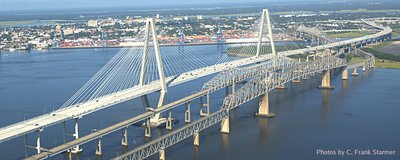The Bridge Blog
A dialog about our new bridge and these web pages
Overview.
Schools and universities are all about learning - and learning is mostlly
brain training. Learning is expedited by repetition and forgetting
is expedited by infrequent use of learned skills or information.
Tracking the building of the Ravenel Bridge and now tracking the
demolition of the Grace and Pearman Bridges bring
many questions to me and help me better understand the role Google
and the Internet play in
just-in-time learning. I enjoy chasing my curiosity and
want to identify ways to encourage younger learners to also enjoy curiosity
chasing and learning.
Many young learners do not understand the importance of repetition. More
important, while experienced learners understand the learning process
they often do not realize the destructive effects of the forgetting
process. Over the course of the
bridge project, I have access to only a few experts.
Rather than a liability, this has become an asset and pushed me to improve
my search skills with Google. Soon, I realized that answers
to questions encountered during my photo adventures were often
only a Google-search away. Gene Stead,
my first boss and I put these ideas together in a small essay:
(see
Restoring the Joy in Learning).
Google + Internet have become dependable extensions of my memory.
Insights I gain from you and this project will find their way into the
learning centers in our schools and universities.
Sun, 28 Aug 2005
August 28, 2005: My surprise: The skill and precision of demolition
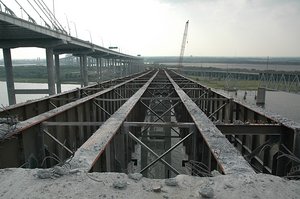 I suppose I always thought that demolition was just another destructive
process - that of removing components until all the structure was reduced
to a pile of rubble. Was I ever wrong. Watching and talking with the
Testa and Jay Cashman guys, I have found that there is skill, precision and
a bit of art in their work. Skill to work the giant grapples, jackhammers
and shears. Precision in removing segments of the road, cleaning the
underlying I-beam surfaces (on the Grace and Pearman bridges) or cutting
the rebar that formed the concrete supporting structures along the
Grace and Pearman approaches and exits and art - somehow instinctively knowing
what and where to apply their what I call, surgical tools.
I suppose I always thought that demolition was just another destructive
process - that of removing components until all the structure was reduced
to a pile of rubble. Was I ever wrong. Watching and talking with the
Testa and Jay Cashman guys, I have found that there is skill, precision and
a bit of art in their work. Skill to work the giant grapples, jackhammers
and shears. Precision in removing segments of the road, cleaning the
underlying I-beam surfaces (on the Grace and Pearman bridges) or cutting
the rebar that formed the concrete supporting structures along the
Grace and Pearman approaches and exits and art - somehow instinctively knowing
what and where to apply their what I call, surgical tools.
Just as I learned of the precision (fractions of an inch) required to
join the edge girders of the new Ravenel Bridge, I have learned from the
Cashman and Testa workers that unbuilding requires similar precision. I
was trained as an electrical engineer - where precision was part of the
discipline. I suppose I was quite guilty of looking at my civil
engineering colleagues as working with precision that was less demanding and
"close enough for highway work". Was I ever wrong! I have totally
reversed my understanding of demolition over the short month
since the demolition of the Grace and Pearman bridges and approaches
started. Another demonstration that even at my age (64 next week) -
continued learning is possible and even necessary.
posted at: 08:35 | path: | permanent link to this entry
Tue, 16 Aug 2005
August 13, 2005: Another very pleasant surprise
 Sparky Witte, a long time resident of Mt. Pleasant, grew up with the Grace and
Pearman bridges. With the Ravenel bridge he has enjoyed being able to walk and
bicycle across the bridge, admiring Mt. Pleasant to the east and Charleston to
the west. He also can watch the unbuilding of the Grace and Pearman bridges.
Sparky Witte, a long time resident of Mt. Pleasant, grew up with the Grace and
Pearman bridges. With the Ravenel bridge he has enjoyed being able to walk and
bicycle across the bridge, admiring Mt. Pleasant to the east and Charleston to
the west. He also can watch the unbuilding of the Grace and Pearman bridges.
Last night, Sparky sent me a group of photos of the July 30 events - the
race and the old car parade. Moreover, he had taken quite a bit of time to
track the demolition of the I-26 and Meeting Street overpasses. I was unable
to stay for all the I-26 work Sunday morning and missed completely the
Meeting Street overpass demolition. So here is part of Sparky's gift - a group
of photos that provided timely tracking of the unbuilding process.
I have added the Meeting Street work to the main page
(tracking the progress over the past days) as well as to the
Meeting St.
page. His photos of the extraction of one set of supporting piers (and cap)
as been added to the
Engineering Challenges page.
Among his photos was one of him - posted above. Clearly, Sparky has brought
new life to our web page, adding photo input to the engineering input I receive
from many people. Sparky - you're the greatest!
posted at: 16:27 | path: | permanent link to this entry
Sat, 13 Aug 2005
August 13, 2005: A suggestion to Mayor Riley and the Transportation Board
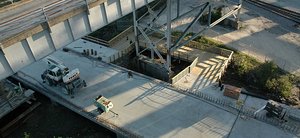 During the construction of the Morrison Street on-ramp, bicycle and pedestrian
walkway, there was an obstacle at the base of the Pearman bridge. A vertical
support structure prevented paving a small section of the bicycle lane. A
small wooden platform was built around the Pearman supports - a sort of
detour.
During the construction of the Morrison Street on-ramp, bicycle and pedestrian
walkway, there was an obstacle at the base of the Pearman bridge. A vertical
support structure prevented paving a small section of the bicycle lane. A
small wooden platform was built around the Pearman supports - a sort of
detour.
With the demolition of the Pearman and Grace moving ahead (briskly), I
understand that this platform will be removed when the vertical supports
are removed, then bicycle lane paving will be completed.
But what a perfect spot to place a few park benches
so that walkers can stop, rest and contemplate not only our wonderful
bridge, but life, the universe and everything. So what about this option,
is it possible to modify the contract with Cashman-Testa to not remove
the wooden platform and for the City to populate it with a few park
benches - particularly useful to maturing adults (age > 60)?
posted at: 08:08 | path: | permanent link to this entry
Thu, 11 Aug 2005
August 11, 2005: A little weather and a little web page design.
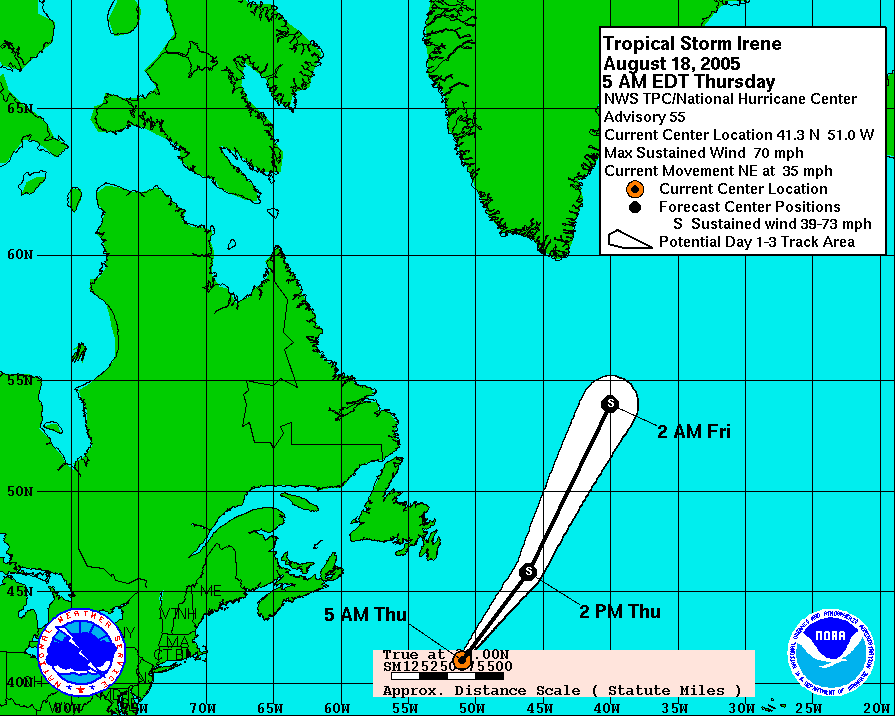 During the construction of the Ravenel
Bridge hurricane cables were installed to provide some lateral stability
under high wind loads. At the same time, I was exploring how to harvest
weather data from NOAA and the National Hurricane Center so that MUSC
faculty, staff, students and worried parents of students (and perhaps worried
parents of faculty / staff) could view primary data without visiting
multiple web sites.
During the construction of the Ravenel
Bridge hurricane cables were installed to provide some lateral stability
under high wind loads. At the same time, I was exploring how to harvest
weather data from NOAA and the National Hurricane Center so that MUSC
faculty, staff, students and worried parents of students (and perhaps worried
parents of faculty / staff) could view primary data without visiting
multiple web sites.
The National Hurricane Center in Miami
provides
RSS (Rich Site Summary) feeds that are small, Internet accessible,
data files that include
links to weather advisories and storm projection graphics. From these links
we wrote a short script to periodically download the updated advisories and
satellite imagery and storm projections. Our
MUSC site presents this
and other harvested data on a single web page.
For the demolition project, I thought it would be useful to present a
minimum set of data so all of us could follow the interactions between
the weather and bridge demolition. Now, Satya Phanse, one of my guys in
the IT Lab thought it would be
useful to selectively display or hide my introductory remarks and worked
out a short segment of
javascript that enables you to display or hide web page segments.
I learn by example, so I copied Satya's example, adapted it to our
bridge page and after 1 mistake (mine) - it works.
posted at: 08:00 | path: | permanent link to this entry
Wed, 10 Aug 2005
August 10, 2005: Demolition in full swing
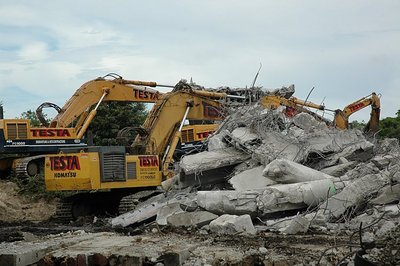 While I always understood that building required more time than
unbuilding I never really felt the difference. Tracking the
construction of the Ravenel Bridge, in retrospect, was a leisurely activity.
Tracking the demolition (I prefer unbuilding) of the Grace and Pearman
structures (bridges as well as approaches) is turning into a twice daily
affair - early morning (6am) and early evening (6pm). I'll keep this
schedule as long as possible. The folks at Jay Cashman - Testa have
been fantastic and helped me understand not only the demolition process
but the sequencing required to manage demolition without shutting Charleston
down for 6 months.
While I always understood that building required more time than
unbuilding I never really felt the difference. Tracking the
construction of the Ravenel Bridge, in retrospect, was a leisurely activity.
Tracking the demolition (I prefer unbuilding) of the Grace and Pearman
structures (bridges as well as approaches) is turning into a twice daily
affair - early morning (6am) and early evening (6pm). I'll keep this
schedule as long as possible. The folks at Jay Cashman - Testa have
been fantastic and helped me understand not only the demolition process
but the sequencing required to manage demolition without shutting Charleston
down for 6 months.
posted at: 09:24 | path: | permanent link to this entry
